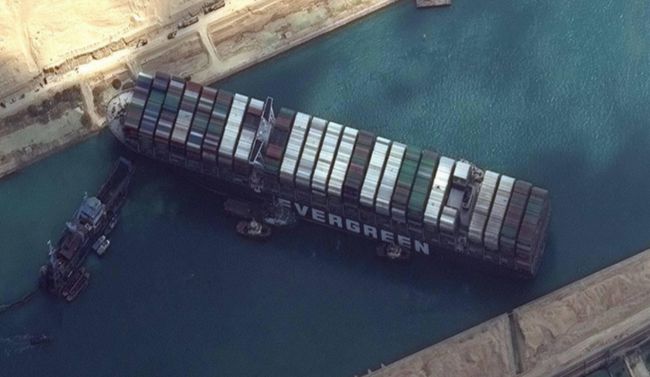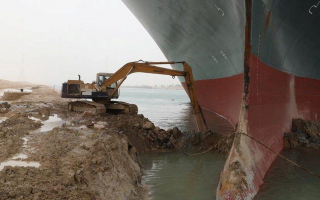长赐号巨型货轮横卡河道 最大赢家是谁
- 2021-03-30 16:43:46
- 点赞量:4723
- 点击量:80662
- 作者:秘书处Secretary's Office

“长赐号”巨型货轮3月21日在苏伊士运河搁浅,横卡河道,阻断了往来交通,影响到中东的路线,并减少了从亚洲的进口量。截至巴西时间3月29日,“长赐号”已重新浮起,苏伊士运河恢复正常通行。
苏伊士运河的瘫痪预计会影响巴西,但是影响的程度将取决于埃及当局解决问题所需的时间。虽然预计直接损失很大,但相比欧洲会小得多,咨询公司Datamar进行的一项调查显示,巴西至少有9%集装箱需要通过该运河,每日平均容积超过1400个标准箱(TEU)。该数据考虑了2020年3月至2021年2月之间,12个月内的所有进出口量。
此次事件对运输肉类、水果、药品等冷藏集装箱的影响最为严重。在该领域中,21%的巴西货物需要通过苏伊士运河,其中主要是出口货物。Datamar总裁洛里默(Andrew Lorimer)称,对巴西而言,受影响的主要是通往中东和远东地区的路线。因此,面向中东国家的肉类出口将遭受巨大损失。
上海-桑托斯航线是巴西贸易的主要航线,该航线每周处理四艘集装箱船,不会受到运河封锁的直接影响,但咨询公司Solve Shipping的合伙人巴雷托(Leandro Barreto)称,这并不意味着这对从亚洲的进口毫无影响。由于巴西对进口的需求非常高,而来自中国的船只在此航线上已满载,因此许多公司转而采用了欧洲航线。沿着这条航线,来自亚洲的集装箱船需要在欧洲和地中海的港口进行转运,再抵达巴西。如果该航线上的船只持续受运河瘫痪影响,那么巴西的进口能力将再次下降,这将致使运费上涨,并影响该国的库存补给。此外,还有许多潜在的间接影响,不仅会影响巴西,而且会影响到整个世界。目前该行业主要担心运河迟迟不能通航,导致海运费率激增以及全球市场上船舶和设备短缺。
德国赫伯罗特航运公司(Hapag Lloyd)巴西负责人费里尼(Luigi Ferrini)称:“问题在于运河瘫痪将持续多久,全球范围内船只和集装箱的短缺可能会产生'涟漪效应'”。该负责人表示如果瘫痪持续两周,那么全球贸易形势将可能非常严峻。Datamar总裁洛里默称:“由于新冠疫情的爆发,海运费已经是个天文数字,并且在全球市场上都有集装箱短缺的情况,已经无法预测何时会恢复正常,而此刻又发生了运河瘫痪事件。现在,即使“长赐号”重新浮起,航道恢复正常,预计也会造成很大的影响。”他预测,即使情况在未来几天内得到解决,但其造成的影响至少要花一个月的时间才能被市场吸收。彭博社的一项调查显示,截至昨日(28日),共有453艘船在排队等待通过苏伊士运河。
另一个问题是燃油价格,因为大多数通过苏伊士运河的船只都运送石油。因此,运费将受到双重压力:一是容积量减少,二是燃料成本增加。巴西跨大西洋海运协会(Centronave)在一份声明中称,现在衡量全球供应链和巴西对外贸易的影响还为时过早。“这仍然是一个推测,没有理由惊慌,因为其影响将主要取决于运河瘫痪的时长。”
自新冠疫情爆发以来,全球集装箱物流行业历经艰辛,不少公司称此为“完美风暴”。各国供需的中断,一些港口的关闭,货物放行的延迟等因素导致了目前全球物流链中船舶和设备短缺的情况,而其结果就是全球海运费飙升,尤其是从亚洲出发的航线。
在巴西,上海-桑托斯航线的运费从2020年10月开始上升,并在今年1月份达到每标准箱10000美金的水平,创下新纪录。从上个月起,情况有所改善。据悉,该运费自去年年底以来在3月份的第一周首次下跌,如今,运费虽仍处于较高水平,但相对更合理,大约每标准箱6000美元。然而,由于此次苏伊士运河事件,世界各地一直在下降的运费将再次上涨。
英文直译
English literal translation
The giant cargo ship "Changci" ran aground in the Suez Canal on March 21, blocking traffic, affecting routes in the Middle East and reducing imports from Asia. As of March 29, Brazil time, "Changci" has been floating again, and the Suez Canal has resumed normal traffic.
The collapse of the Suez Canal is expected to affect Brazil, but the extent of the impact will depend on the time it takes Egyptian authorities to resolve the problem. Although the direct loss is expected to be large, it will be much smaller than that in Europe. According to a survey conducted by datamar, a consulting firm, at least 9% of the containers in Brazil need to pass through the canal, with an average volume of more than 1400 TEUs per day. This data takes into account all imports and exports in the 12 months from March 2020 to February 2021.
The impact of this incident on the transportation of meat, fruit, medicine and other refrigerated containers is the most serious. In this area, 21% of Brazilian goods need to go through the Suez Canal, mainly for export. Andrew Lorimer, President of datamar, said that for Brazil, the route to the Middle East and Far East was mainly affected. As a result, meat exports to Middle East countries will suffer huge losses.
Leandro Barreto, a partner at firm. As Brazil's demand for imports is very high and ships from China are fully loaded on this route, many companies have switched to European routes. Along this route, container ships from Asia need to transship at ports in Europe and the Mediterranean before arriving in Brazil. If ships on the route continue to be affected by the canal paralysis, Brazil's import capacity will decline again, which will lead to higher freight rates and affect the country's inventory replenishment. In addition, there are many potential indirect impacts that will affect not only Brazil, but the world as a whole. At present, the main concern of the industry is that the canal is not navigable for a long time, resulting in a surge in ocean freight rates and a shortage of ships and equipment in the global market.
Luigi ferrini, head of Brazil for Germany's Hapag Lloyd, said: "the question is how long the canal will be paralyzed, and the global shortage of ships and containers may have a 'ripple effect'". The official said that if the paralysis lasts for two weeks, then the global trade situation may be very severe. "Because of the outbreak of COVID-19, ocean freight is already an astronomical figure, and there is a shortage of containers in the global market. It is impossible to predict when it will return to normal," said Datamar, President of the company. Now, even if the "Changci" floats up again and the channel returns to normal, it is expected to have a great impact. " He predicts that even if the situation is resolved in the next few days, its impact will take at least a month to be absorbed by the market. A total of 453 ships were waiting in line to pass the Suez Canal, according to a survey conducted by the Ibero news agency yesterday.
Another problem is the price of fuel, because most of the ships through the Suez Canal carry oil. Therefore, freight will be subject to double pressure: first, the volume will be reduced, and second, the fuel cost will be increased. It is too early to measure the impact of global supply chains and Brazil's foreign trade, centronave said in a statement. "It's still a speculation and there's no reason to panic, because the impact will depend largely on the length of time the canal is paralyzed."
Since the outbreak of covid-19, the global container logistics industry has been through hardships. Many companies call this the perfect storm. The interruption of supply and demand in various countries, the closure of some ports, the delay of cargo release and other factors have led to the shortage of ships and equipment in the global logistics chain. As a result, the global ocean freight soars, especially the routes from Asia.
In Brazil, the freight of Shanghai Santos line began to rise in October 2020 and reached a new record of US $10000 per TEU in January this year. The situation has improved since last month. It is reported that the freight fell for the first time in the first week of March since the end of last year. Today, although the freight is still at a high level, it is relatively more reasonable, about US $6000 per TEU. However, due to the Suez Canal incident, freight rates that have been falling around the world will rise again.




0 条 评 论 Write a Response